Last updated on
Discover the ideal moment to revamp your culinary space as we delve into the best time to remodel a kitchen, ensuring minimal disruption and maximum efficiency.
The kitchen is the heart of every home. It’s where we cook, eat, and gather with our loved ones.
But what happens when your kitchen starts to look outdated or doesn’t function as well as it used to? That’s when you start thinking about remodeling. However, deciding on the best time to remodel your kitchen can be a daunting task.
Should you do it during the summer or winter? Is there a specific month that’s better than others? In this article, we’ll explore all the factors that come into play when deciding on the best time to remodel your kitchen. So grab a cup of coffee and let’s get started!
What's Inside
Assessing Your Kitchen Needs

Before embarking on a kitchen remodel, it’s essential to assess your current needs and identify what you want to achieve with the renovation. Start by evaluating how you use your kitchen space.
Do you cook frequently? Do you entertain guests often? Is there enough storage for all of your cooking equipment and utensils? Are there any safety concerns that need addressing?
Once you’ve identified the areas that require improvement, consider how much space is available in your kitchen. If it’s too small or cramped, then expanding the area may be necessary.
Another crucial factor to consider is functionality. Your new design should make cooking easier and more efficient while also accommodating other activities such as dining or socializing.
By assessing these needs upfront, homeowners can create a clear vision for their ideal culinary space before diving into remodeling plans with contractors or designers.
Benefits of Remodeling

First, it can increase the value of your property if you plan on selling in the future. A modern and functional kitchen is a major selling point for potential buyers.
Secondly, remodeling allows you to customize your space according to your needs and preferences. You may want more storage or counter space, better lighting or appliances that are energy-efficient.
Thirdly, remodeling gives you an opportunity to update outdated features such as old cabinets or countertops with new materials that are durable and easy-to-maintain.
Lastly, renovating also improves the overall functionality of the room by optimizing workflow patterns which makes cooking easier while enhancing safety measures in place like installing slip-resistant flooring surfaces.
Setting a Budget

It’s essential to determine how much money you’re willing to spend on the project before starting any work. Setting a budget will help guide your decisions throughout the renovation process and ensure that you don’t overspend.
When creating your budget, consider all aspects of the remodeling project, including materials, labor costs, permits fees (if applicable), and unexpected expenses. Be realistic about what you can afford while also keeping in mind that investing in quality materials or hiring professionals may save money in the long run by reducing maintenance costs or increasing home value.
It’s crucial not only to set a total amount for your kitchen remodel but also allocate funds for each aspect of it such as appliances, countertops or cabinetry options so that there are no surprises later on during construction.
Choosing a Design Style
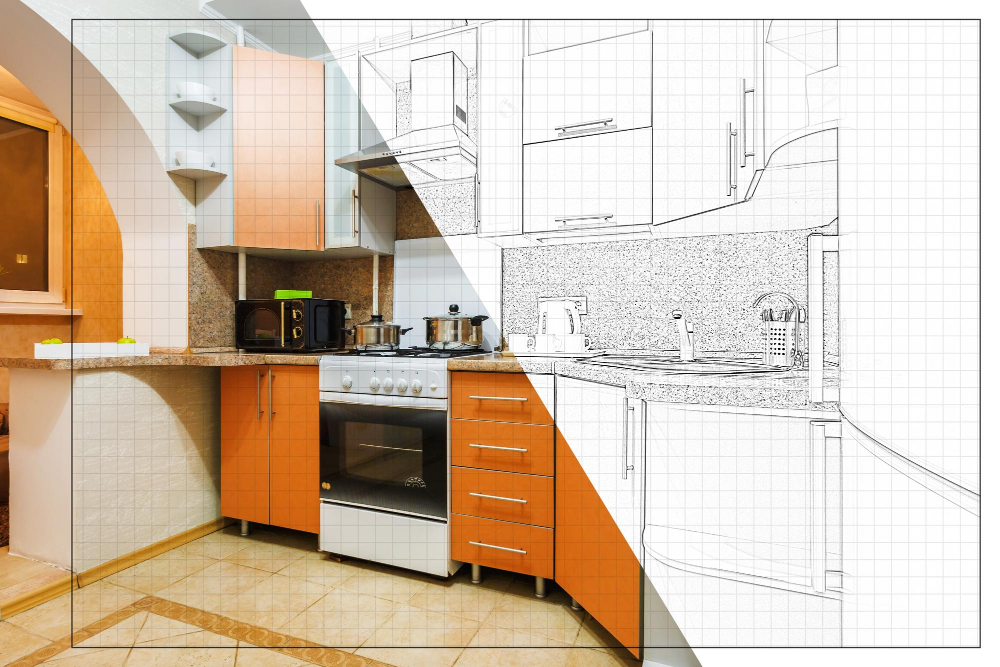
The design style you choose will determine the overall look and feel of your new kitchen. There are several popular styles to consider, including traditional, modern, farmhouse, industrial or minimalist.
Traditional kitchens often feature ornate details such as crown molding and raised-panel cabinets with decorative hardware. Modern kitchens tend to have clean lines with sleek finishes like stainless steel appliances and flat-panel cabinetry.
Farmhouse-style kitchens are cozy spaces that evoke feelings of warmth through natural materials like wood floors or shiplap walls paired with vintage-inspired fixtures such as apron-front sinks or rustic pendant lighting.
Industrial-style kitchens typically feature exposed brick walls combined with metal accents like stainless steel countertops for an edgy yet functional vibe while minimalist designs focus on simplicity by using neutral colors paired down surfaces without any unnecessary adornments.
Selecting Appliances
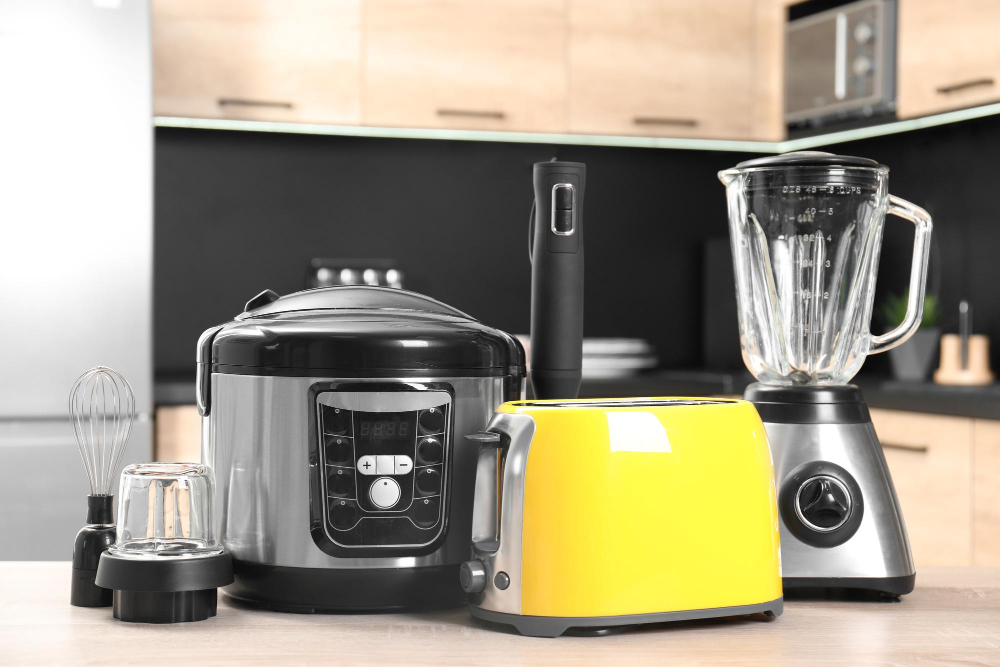
First and foremost, think about the size of your family and how much cooking you do on a regular basis. This will help determine what type of stove, oven, refrigerator or dishwasher is best suited for your needs.
Another important factor is energy efficiency. Look for appliances that have an Energy Star rating as they can save you money on utility bills in the long run while also being environmentally friendly.
Lastly, don’t forget about style! Appliances come in various finishes such as stainless steel or black matte which can complement any design style from modern to traditional.
Picking Countertops
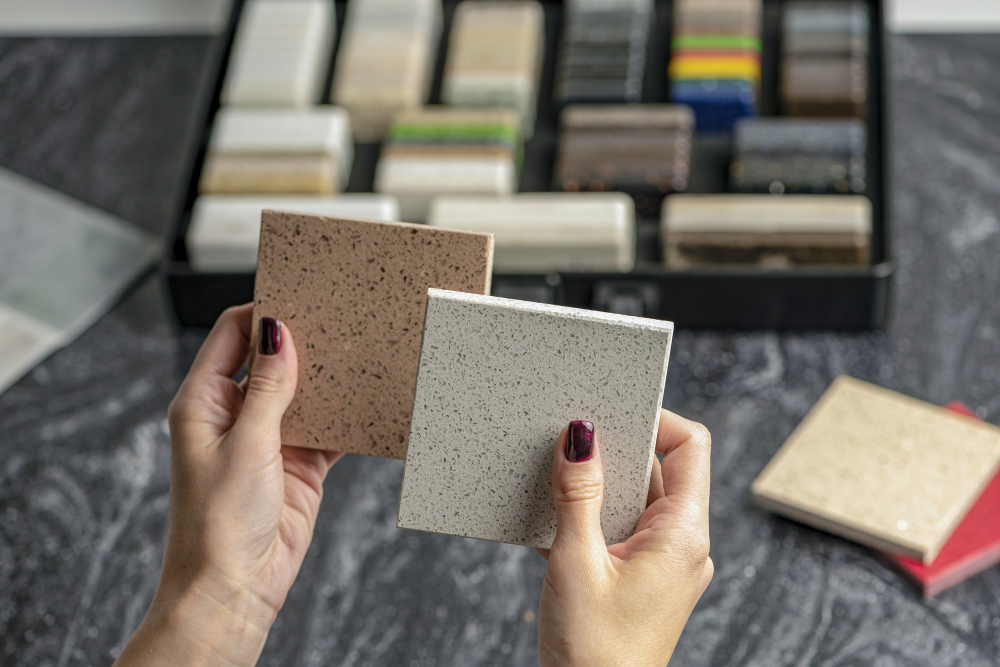
They not only add to the aesthetic appeal but also serve as a functional workspace. When choosing countertops, consider your lifestyle and budget.
If you’re someone who loves cooking and spends a lot of time in the kitchen, then investing in durable materials like granite or quartz may be worth it.
On the other hand, if you’re on a tight budget, laminate countertops can provide an affordable option that still looks great. Another factor to consider is maintenance – some materials require more upkeep than others.
Ultimately, it’s essential to choose something that complements your design style while being practical for everyday use. Don’t forget about color options too! Neutral colors like white or gray are timeless choices that will never go out of style; however bold colors can make for an eye-catching statement piece.
Cabinetry Options

Not only do cabinets provide storage space, but they also set the tone for your kitchen’s overall design style. When choosing cabinetry options, consider factors such as material, color, and hardware.
Wooden cabinets are a classic choice that can add warmth and character to any kitchen. Oak and maple are popular wood choices due to their durability and versatility in terms of staining or painting them different colors.
For those who prefer a more modern look, metal or glass-fronted cabinets may be an option worth considering. These materials offer sleek lines that can give your kitchen an industrial feel while still providing ample storage space.
When it comes to cabinet hardware (handles/knobs), there are endless options available on the market today – from traditional brass handles to contemporary stainless steel pulls – so you’re sure to find something that suits your taste!
Flooring Choices
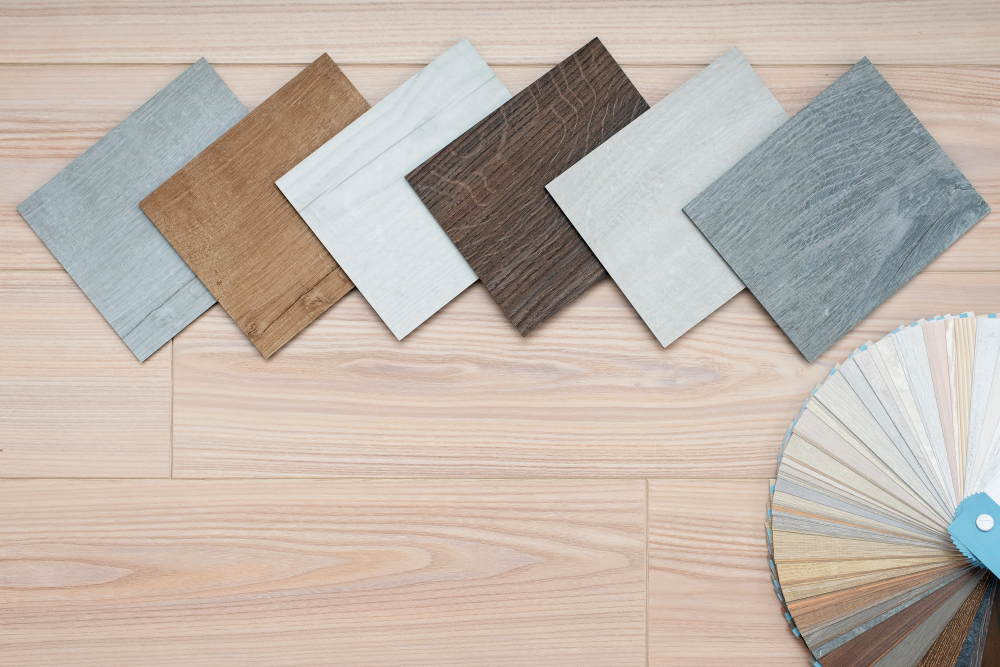
It not only adds to the aesthetic appeal but also plays a crucial role in functionality and safety. When choosing flooring for your new kitchen, consider factors such as durability, ease of maintenance, slip-resistance, and style.
Hardwood floors are a popular choice for many homeowners due to their timeless look and durability. They come in various finishes that can complement any design style from traditional to modern.
Tile flooring is another excellent option that offers versatility in terms of color choices and patterns. It’s easy to clean up spills on tile floors making them ideal for busy kitchens with high traffic areas.
Vinyl or linoleum flooring provides an affordable alternative while still offering great options when it comes to colors and designs. These materials are durable enough even if you have pets or kids running around the house all day long.
Ultimately, your choice will depend on personal preference as well as practical considerations like budget constraints or lifestyle needs (e.g., allergies).
Lighting Considerations
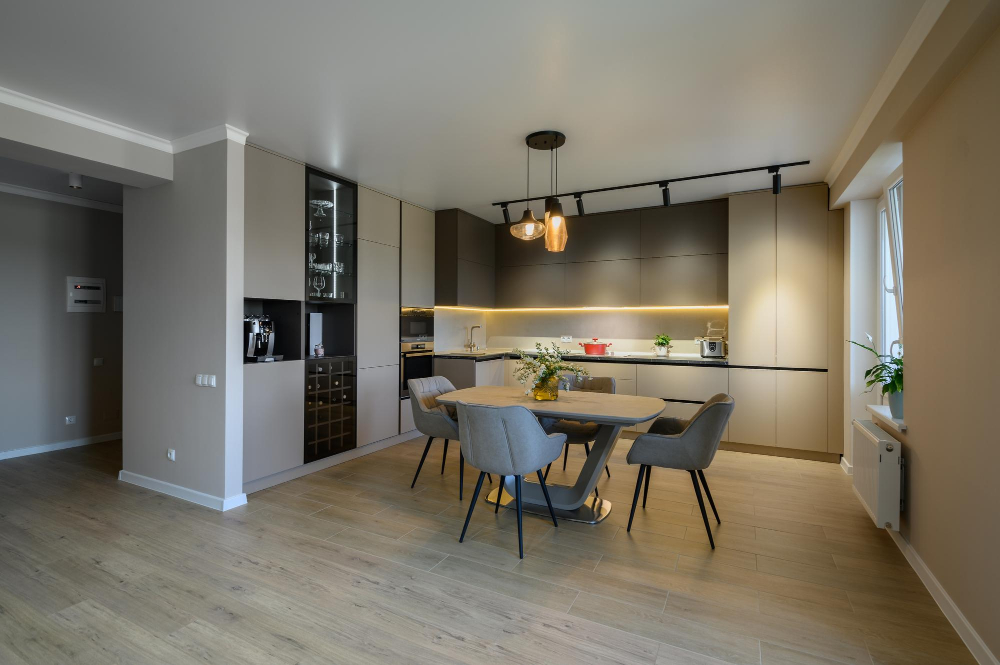
It can make or break the ambiance and functionality of your space. When considering lighting options, think about the different areas in your kitchen that require illumination, such as task lighting for food preparation and cooking, ambient lighting for overall brightness, and accent lighting to highlight specific features like artwork or architectural details.
Under-cabinet lights are a popular choice for task lighting as they provide ample light on countertops where you need it most. Pendant lights over islands or dining tables add a stylish touch while providing adequate illumination.
When selecting bulbs for your fixtures, consider their color temperature (measured in Kelvin). Warm white (2700K-3000K) creates a cozy atmosphere while cool white (3500K-4100K) provides brighter light ideal for workspaces.
Lastly, don’t forget to install dimmer switches so you can adjust the intensity of your lights according to different occasions – from brightening up during meal prep time to creating an intimate mood during dinner parties with friends and family.
Storage Solutions
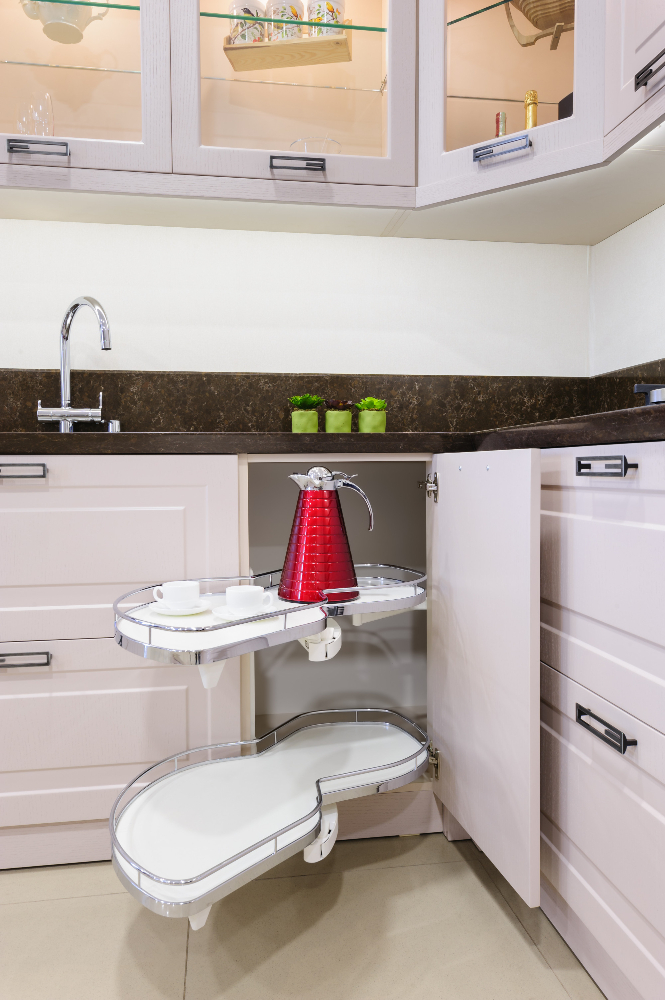
A well-designed kitchen should have enough room to store all your cooking essentials, including pots and pans, dishes, utensils, and food items. When planning your renovation project, consider incorporating smart storage solutions that maximize every inch of available space.
Some popular options for increasing storage in the kitchen include installing pull-out drawers or shelves in cabinets to make it easier to access items at the back; adding a pantry cabinet with adjustable shelving for storing dry goods; using vertical dividers inside drawers for organizing baking sheets and cutting boards; or even building custom cabinetry that fits perfectly into awkward corners.
Hiring Professionals

While some homeowners may opt for DIY projects, hiring professionals can save you time and money in the long run. Professional contractors have years of experience in kitchen remodeling and can help you avoid costly mistakes.
When looking for professionals, start by asking friends or family members who have recently remodeled their kitchens for recommendations. You can also check online reviews or ask your local home improvement store for referrals.
Once you’ve narrowed down your list of potential contractors, schedule consultations with each one to discuss your project’s scope and budget. During these meetings, be sure to ask about their experience with similar projects as well as any certifications they hold.
It’s also crucial that you feel comfortable working with the contractor since this will be an ongoing relationship throughout the renovation process. Make sure they are willing to communicate regularly about progress updates or any issues that arise during construction.
DIY Vs. Contractor

While DIY projects can save you money, they also require a lot of time and effort on your part. You’ll need to be comfortable with tools, have some basic knowledge of construction and design principles, and be willing to put in long hours.
On the other hand, hiring a professional contractor can take away much of the stress associated with remodeling projects. They will handle everything from planning and design through installation while ensuring that all work meets local building codes.
Ultimately, deciding between DIY or hiring a contractor comes down to personal preference as well as budget constraints.
Permits and Regulations

Depending on where you live, there may be specific rules that dictate what type of work can be done in a residential area. For example, some cities require homeowners to obtain permits for electrical or plumbing work.
Failing to comply with these regulations could result in hefty fines or even legal action against you. It’s always better to err on the side of caution and make sure everything is above board before starting any renovations.
To ensure that all necessary permits are obtained and regulations are followed correctly, consider hiring a professional contractor who has experience working within your local jurisdiction. They will know exactly what needs to be done and can take care of all the paperwork for you.
Time and Duration
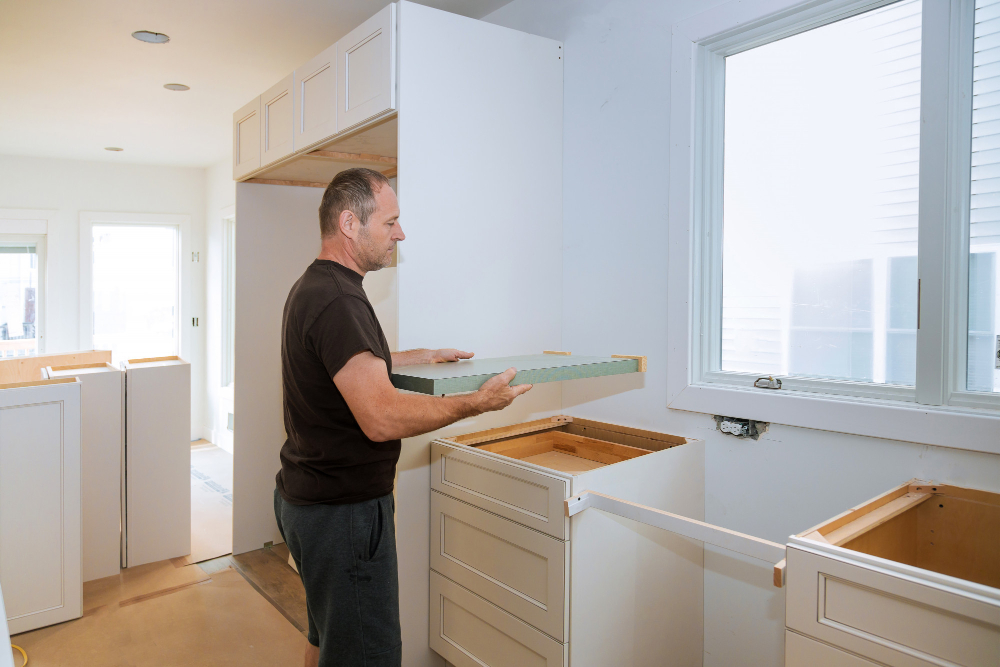
A minor renovation that involves replacing countertops or updating appliances may take only a few days to complete. However, if you’re planning a major overhaul that includes structural changes or moving plumbing fixtures around, it could take several weeks or even months.
It’s important to consider your schedule when deciding on the best time for your kitchen remodel. If you have an upcoming event like hosting Thanksgiving dinner at home in November or having guests over during Christmas break in December, then plan accordingly so that your new kitchen is ready before those events.
Also keep in mind any other renovations happening simultaneously with your kitchen remodeling project as this will impact timelines too. For example if you are also renovating bathrooms at same time then there might be some delays due to shared resources such as contractors etc.
Lastly remember product lead times – ordering custom cabinets can take up 6-8 weeks alone! So make sure all products are ordered well ahead of start date so they arrive on site when needed.
Seasonal Considerations
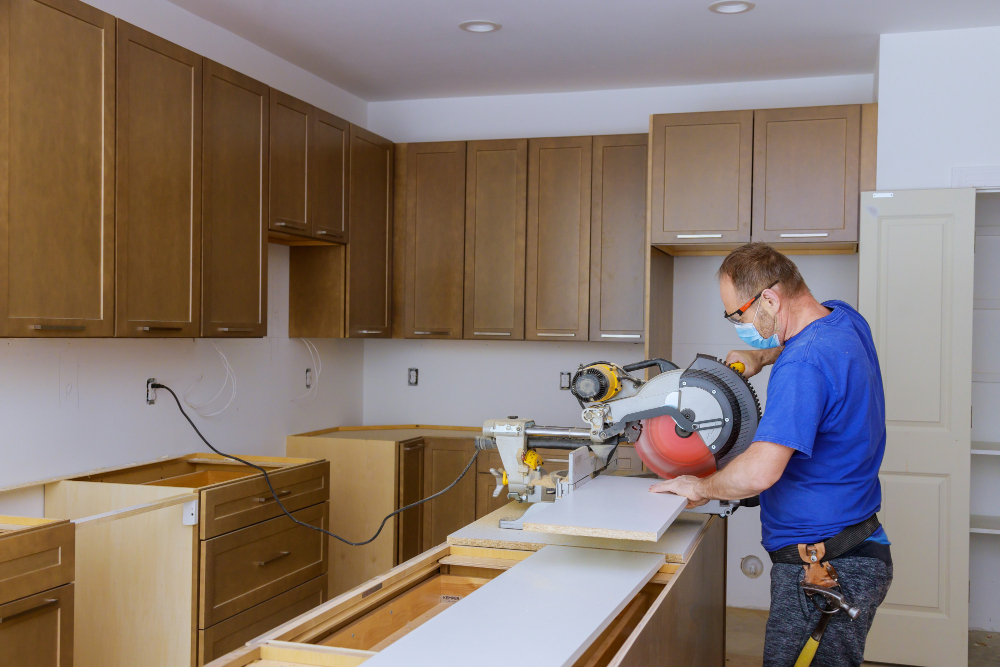
For instance, if you decide to renovate during the winter months, it may take longer due to inclement weather conditions that could delay deliveries and installations. On the other hand, remodeling in summer or spring might be more convenient as there are fewer chances of delays caused by bad weather.
Another factor is how busy contractors are during certain seasons. Summer is usually peak season for home renovations because many homeowners prefer doing their projects when they’re not at work or school.
This means that contractors may be booked up well in advance and prices could go up due to high demand.
Conversely, winter months tend to be slower for renovation companies since most people don’t want construction happening around holiday gatherings or cold temperatures making it less comfortable for workers on site.
Planning Around Holidays

If you’re planning a major renovation, it’s crucial to avoid scheduling it during peak holiday seasons like Thanksgiving or Christmas. These are times when family and friends gather in the kitchen, and any disruption can be stressful for everyone involved.
It’s also important to keep in mind that many contractors take time off during the holidays, which could delay your project timeline significantly. Therefore, if you want your new kitchen ready before a specific holiday season or event at home, plan ahead of time.
On the other hand, some homeowners prefer remodeling their kitchens during these periods because they have more free time from work obligations. However tempting this may seem; it’s advisable not only for practical reasons but also financial ones since prices tend to go up due to high demand.
Planning around holidays requires careful consideration of several factors such as contractor availability and potential disruptions caused by renovations while hosting guests at home.
Coordinating With Other Renovations

For instance, if you’re renovating your kitchen and bathroom simultaneously, make sure that both contractors are aware of each other’s schedules. This way, they can work together to minimize disruptions and ensure that everything runs smoothly.
It’s also crucial to consider the order in which renovations will take place. If you plan on replacing flooring throughout your home or painting walls in adjacent rooms, it may be best to do those projects before tackling the kitchen renovation.
By coordinating with other renovations happening in your home at the same time as a kitchen remodel project ensures minimal disruption and maximum efficiency while saving time and money on labor costs for multiple jobs being done at once.
.
Remodeling a kitchen is an exciting but challenging task that requires careful consideration of various factors such as budgeting, design style selection appliances & countertops options among others discussed above.
Product Lead Times

These items can take weeks or even months to arrive after ordering them. Therefore, you need to factor in these lead times when setting your project timeline.
To avoid delays and ensure that everything is ready on time for installation day, make sure you order all necessary products well in advance of your scheduled start date. It’s also crucial to work with a reputable supplier who can provide accurate delivery estimates and keep you informed throughout the process.
Preparing for Disruptions

Before you start any work, make sure you have a plan in place to minimize the impact on your daily routine. This includes setting up temporary cooking facilities if necessary, moving furniture out of harm’s way, covering floors and other surfaces with protective materials.
It is also important to communicate clearly with your contractor about what areas of the house will be affected by construction activities so that they can take appropriate measures such as sealing off doorways or using dust barriers.
Enjoying Your New Kitchen

You can now cook and entertain in a space that reflects your style and meets all of your needs. Take some time to appreciate the new features you’ve added, such as extra storage or a more efficient layout.
Host a dinner party or invite friends over for brunch to show off your new space.
But enjoying your new kitchen doesn’t stop there – it also means taking care of it properly so that it lasts for years to come. Make sure you follow any maintenance instructions provided by manufacturers for appliances, countertops, flooring, and cabinetry.
Regular cleaning will also help keep everything looking fresh and clean. Wipe down surfaces after each use with mild soap and water or an appropriate cleaner recommended by the manufacturer.
Remodeling a kitchen takes planning but can be well worth the effort when done correctly at an ideal time frame with proper budgeting considerations taken into account along with hiring professionals where necessary while keeping up-to-date on permits & regulations required in one’s area; ultimately leading towards enjoying one’s newly renovated culinary haven!
FAQ
What time of year is cheapest to remodel?
The cheapest time of year to remodel is during the early part of the year, between the holidays and summer vacation, when contractors are more available and products are easier to procure.
What is the average length of time between kitchen remodels?
The average length of time between kitchen remodels is 6-12 weeks, depending on the size and complexity of the project.
How can homeowners minimize disruption to their daily routines during a kitchen remodel?
To minimize disruption during a kitchen remodel, homeowners can set up a temporary kitchen in another room with essential appliances and equipment.
Which kitchen remodeling projects typically provide the best return on investment?
Kitchen remodeling projects that typically provide the best return on investment include minor upgrades, such as updating appliances, countertops, and cabinets.
How can one choose a reliable contractor for a kitchen remodel project?
One can choose a reliable contractor for a kitchen remodel project by researching and comparing their experience, reviews, references, credentials, and obtaining written estimates before making a decision.




